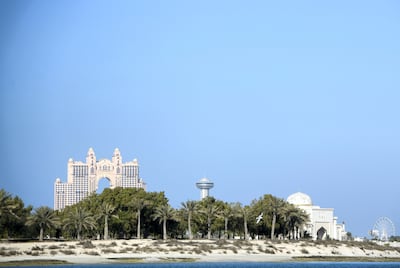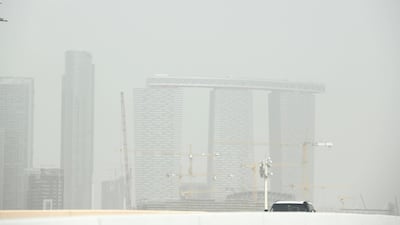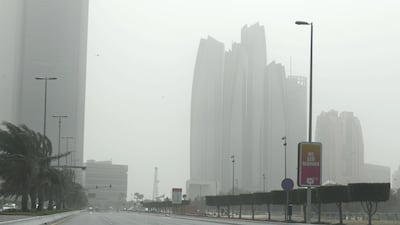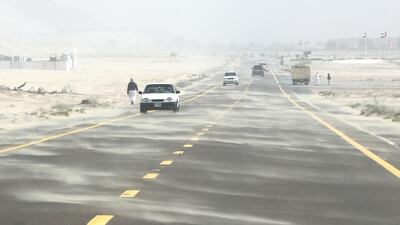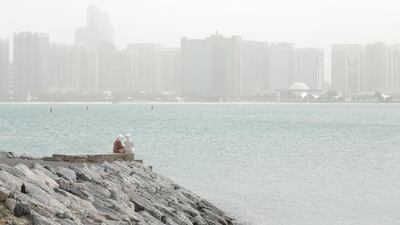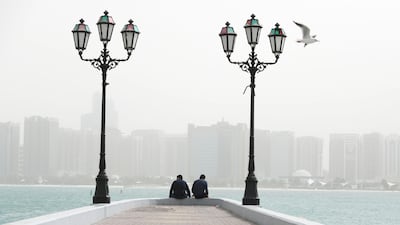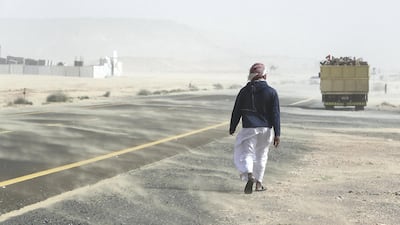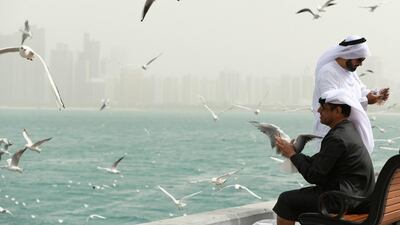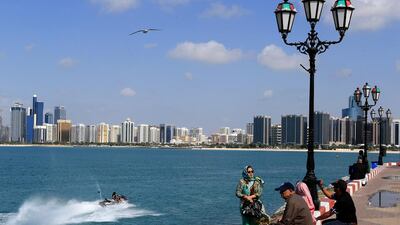Abu Dhabi has expanded a programme aimed at improving air quality in the emirate.
Experts from Environment Agency Abu Dhabi (EAD) have joined the World Health Organisation’s Global Air Pollution and Health Technical Advisory Group.
They now sit on two working groups – one focused on dust, sand and health and the other on policy interventions.
It is hoped the knowledge gained in the groups can help the emirate continue recent strides made to improve air quality.
In the past year, our air quality on 83 per cent of the days had good or moderate air quality
Ruqaya Mohamed,
Environment Agency Abu Dhabi
Air quality is not only affected by pollutants, but also by ozone, dust and sand, which can pick up and carry other contaminants on the way.
A network of 22 air monitors across the emirate, 20 of which are fixed while two are mobile, assess what is coming from where to help regulate it.
“In the past year, our air quality on 83 per cent of the days had good or moderate air quality, which is green and yellow and relatively healthy for the general population,” Ruqaya Mohamed, section manager, air quality, noise and climate change at EAD told The National.
“Of course, we have those days where we have peaks of dust and also sometimes ozone. These two particular pollutants are largely affected by the regional climate and natural sources.”
The emirate’s air monitors track 14 pollutants to check how healthy or unhealthy the air is.
That data is then fed into a publicly available Abu Dhabi air quality dashboard where people can see for themselves if it is safe to spend time outdoors.
On Friday, the dashboard showed that many areas of the emirate were classed as green on the index, meaning the air posed no health concern.
Days when the air quality is particularly poor air are often the result of dust, sand and ground level ozone, Ms Mohamed said.
“When we say ozone, most people focus on the hole in the ozone layer, but there is also ozone at the level we breathe. This is one of the pollutants we monitor,” she said.
“The difference between ozone and other pollutants is that ozone is emitted; it’s created. It’s a mix of other pollutants coming together. You have nitrous oxide, volatile organic compounds, plus heat. A lot of sunshine, a lot of sunlight.
“It could be created 100 kilometres from here and it will come here. Or the things that are required to create it are created elsewhere.
“It’s important to study where the sources are. That’s what we are doing with the agency.”
During the early days of the pandemic, concentrations of nitrogen dioxide, sulphur dioxide and carbon monoxide – all pollutants released by vehicles – plunged, in some cases as much as 70 per cent.
Springer Nature published a paper by the EAD on the topic, based on its findings.
However, a recent study by scientists in the Emirates found that concentrations of tiny particulate matter in the air in eastern Arabia, including the UAE, actually increased during the period.
The increase resulted from an unusually active period of dust storms caused by the region’s shamal winds.
“You could have a sand storm here and the impact on what is carried on the sand or in the sand is completely different,” Ms Mohamed said.
“The sand storm could have the same origin but depending on where it passes by the time it reaches your place or my place it carries all sorts of things along the way.”
That includes things such as pollutants or even viruses, bacteria and fungi, she said.
The study reports that from March to June 2020, the level of particulate matter in eastern Arabia was 30 per cent higher than the average seen from 2016 to 2019.
Particulate matter can cause health effects including everything from sneezing and a runny nose to heart disease and lung cancer.
The%20specs
%3Cp%3E%3Cstrong%3EEngine%3A%3C%2Fstrong%3E%201.5-litre%204-cylinder%3Cbr%3E%3Cstrong%3ETransmission%3A%20%3C%2Fstrong%3ECVT%3Cbr%3E%3Cstrong%3EPower%3A%20%3C%2Fstrong%3E119bhp%3Cbr%3E%3Cstrong%3ETorque%3A%20%3C%2Fstrong%3E145Nm%3Cbr%3E%3Cstrong%3EPrice%3A%20%3C%2Fstrong%3EDh%2C89%2C900%20(%2424%2C230)%3Cbr%3E%3Cstrong%3EOn%20sale%3A%20%3C%2Fstrong%3Enow%3C%2Fp%3E%0A
Mercer, the investment consulting arm of US services company Marsh & McLennan, expects its wealth division to at least double its assets under management (AUM) in the Middle East as wealth in the region continues to grow despite economic headwinds, a company official said.
Mercer Wealth, which globally has $160 billion in AUM, plans to boost its AUM in the region to $2-$3bn in the next 2-3 years from the present $1bn, said Yasir AbuShaban, a Dubai-based principal with Mercer Wealth.
“Within the next two to three years, we are looking at reaching $2 to $3 billion as a conservative estimate and we do see an opportunity to do so,” said Mr AbuShaban.
Mercer does not directly make investments, but allocates clients’ money they have discretion to, to professional asset managers. They also provide advice to clients.
“We have buying power. We can negotiate on their (client’s) behalf with asset managers to provide them lower fees than they otherwise would have to get on their own,” he added.
Mercer Wealth’s clients include sovereign wealth funds, family offices, and insurance companies among others.
From its office in Dubai, Mercer also looks after Africa, India and Turkey, where they also see opportunity for growth.
Wealth creation in Middle East and Africa (MEA) grew 8.5 per cent to $8.1 trillion last year from $7.5tn in 2015, higher than last year’s global average of 6 per cent and the second-highest growth in a region after Asia-Pacific which grew 9.9 per cent, according to consultancy Boston Consulting Group (BCG). In the region, where wealth grew just 1.9 per cent in 2015 compared with 2014, a pickup in oil prices has helped in wealth generation.
BCG is forecasting MEA wealth will rise to $12tn by 2021, growing at an annual average of 8 per cent.
Drivers of wealth generation in the region will be split evenly between new wealth creation and growth of performance of existing assets, according to BCG.
Another general trend in the region is clients’ looking for a comprehensive approach to investing, according to Mr AbuShaban.
“Institutional investors or some of the families are seeing a slowdown in the available capital they have to invest and in that sense they are looking at optimizing the way they manage their portfolios and making sure they are not investing haphazardly and different parts of their investment are working together,” said Mr AbuShaban.
Some clients also have a higher appetite for risk, given the low interest-rate environment that does not provide enough yield for some institutional investors. These clients are keen to invest in illiquid assets, such as private equity and infrastructure.
“What we have seen is a desire for higher returns in what has been a low-return environment specifically in various fixed income or bonds,” he said.
“In this environment, we have seen a de facto increase in the risk that clients are taking in things like illiquid investments, private equity investments, infrastructure and private debt, those kind of investments were higher illiquidity results in incrementally higher returns.”
The Abu Dhabi Investment Authority, one of the largest sovereign wealth funds, said in its 2016 report that has gradually increased its exposure in direct private equity and private credit transactions, mainly in Asian markets and especially in China and India. The authority’s private equity department focused on structured equities owing to “their defensive characteristics.”
Manchester United v Club America
When: Thursday, 9pm Arizona time (Friday UAE, 8am)
Our family matters legal consultant
Name: Hassan Mohsen Elhais
Position: legal consultant with Al Rowaad Advocates and Legal Consultants.
Five famous companies founded by teens
There are numerous success stories of teen businesses that were created in college dorm rooms and other modest circumstances. Below are some of the most recognisable names in the industry:
- Facebook: Mark Zuckerberg and his friends started Facebook when he was a 19-year-old Harvard undergraduate.
- Dell: When Michael Dell was an undergraduate student at Texas University in 1984, he started upgrading computers for profit. He starting working full-time on his business when he was 19. Eventually, his company became the Dell Computer Corporation and then Dell Inc.
- Subway: Fred DeLuca opened the first Subway restaurant when he was 17. In 1965, Mr DeLuca needed extra money for college, so he decided to open his own business. Peter Buck, a family friend, lent him $1,000 and together, they opened Pete’s Super Submarines. A few years later, the company was rebranded and called Subway.
- Mashable: In 2005, Pete Cashmore created Mashable in Scotland when he was a teenager. The site was then a technology blog. Over the next few decades, Mr Cashmore has turned Mashable into a global media company.
- Oculus VR: Palmer Luckey founded Oculus VR in June 2012, when he was 19. In August that year, Oculus launched its Kickstarter campaign and raised more than $1 million in three days. Facebook bought Oculus for $2 billion two years later.
The five pillars of Islam
The%20specs%3A%202024%20Mercedes%20E200
%3Cp%3E%3Cstrong%3EEngine%3A%20%3C%2Fstrong%3E2.0-litre%20four-cyl%20turbo%20%2B%20mild%20hybrid%0D%3Cbr%3E%3Cstrong%3EPower%3A%20%3C%2Fstrong%3E204hp%20at%205%2C800rpm%20%2B23hp%20hybrid%20boost%0D%3Cbr%3E%3Cstrong%3ETorque%3A%20%3C%2Fstrong%3E320Nm%20at%201%2C800rpm%20%2B205Nm%20hybrid%20boost%0D%3Cbr%3E%3Cstrong%3ETransmission%3A%20%3C%2Fstrong%3E9-speed%20auto%0D%3Cbr%3E%3Cstrong%3EFuel%20consumption%3A%20%3C%2Fstrong%3E7.3L%2F100km%0D%3Cbr%3E%3Cstrong%3EOn%20sale%3A%20%3C%2Fstrong%3ENovember%2FDecember%0D%3Cbr%3E%3Cstrong%3EPrice%3A%20%3C%2Fstrong%3EFrom%20Dh205%2C000%20(estimate)%3C%2Fp%3E%0A
The biog
Name: Abeer Al Bah
Born: 1972
Husband: Emirati lawyer Salem Bin Sahoo, since 1992
Children: Soud, born 1993, lawyer; Obaid, born 1994, deceased; four other boys and one girl, three months old
Education: BA in Elementary Education, worked for five years in a Dubai school
Dubai Rugby Sevens, December 5 -7
World Sevens Series Pools
A – Fiji, France, Argentina, Japan
B – United States, Australia, Scotland, Ireland
C – New Zealand, Samoa, Canada, Wales
D – South Africa, England, Spain, Kenya
Duterte Harry: Fire and Fury in the Philippines
Jonathan Miller, Scribe Publications
Cricket World Cup League 2
UAE results
Lost to Oman by eight runs
Beat Namibia by three wickets
Lost to Oman by 12 runs
Beat Namibia by 43 runs
UAE fixtures
Free admission. All fixtures broadcast live on icc.tv
Tuesday March 15, v PNG at Sharjah Cricket Stadium
Friday March 18, v Nepal at Dubai International Stadium
Saturday March 19, v PNG at Dubai International Stadium
Monday March 21, v Nepal at Dubai International Stadium
From Zero
Artist: Linkin Park
Label: Warner Records
Number of tracks: 11
Rating: 4/5
AL%20BOOM
%3Cp%20style%3D%22text-align%3Ajustify%3B%22%3E%26nbsp%3B%26nbsp%3B%26nbsp%3BDirector%3AAssad%20Al%20Waslati%26nbsp%3B%3C%2Fp%3E%0A%3Cp%20style%3D%22text-align%3Ajustify%3B%22%3E%0DStarring%3A%20Omar%20Al%20Mulla%2C%20Badr%20Hakami%20and%20Rehab%20Al%20Attar%0D%3Cbr%3E%0D%3Cbr%3EStreaming%20on%3A%20ADtv%0D%3Cbr%3E%0D%3Cbr%3ERating%3A%203.5%2F5%0D%3Cbr%3E%0D%3Cbr%3E%3C%2Fp%3E%0A
Key findings of Jenkins report
- Founder of the Muslim Brotherhood, Hassan al Banna, "accepted the political utility of violence"
- Views of key Muslim Brotherhood ideologue, Sayyid Qutb, have “consistently been understood” as permitting “the use of extreme violence in the pursuit of the perfect Islamic society” and “never been institutionally disowned” by the movement.
- Muslim Brotherhood at all levels has repeatedly defended Hamas attacks against Israel, including the use of suicide bombers and the killing of civilians.
- Laying out the report in the House of Commons, David Cameron told MPs: "The main findings of the review support the conclusion that membership of, association with, or influence by the Muslim Brotherhood should be considered as a possible indicator of extremism."
Wenger's Arsenal reign in numbers
1,228 - games at the helm, ahead of Sunday's Premier League fixture against West Ham United.
704 - wins to date as Arsenal manager.
3 - Premier League title wins, the last during an unbeaten Invincibles campaign of 2003/04.
1,549 - goals scored in Premier League matches by Wenger's teams.
10 - major trophies won.
473 - Premier League victories.
7 - FA Cup triumphs, with three of those having come the last four seasons.
151 - Premier League losses.
21 - full seasons in charge.
49 - games unbeaten in the Premier League from May 2003 to October 2004.
MEFCC information
Tickets range from Dh110 for an advance single-day pass to Dh300 for a weekend pass at the door. VIP tickets have sold out. Visit www.mefcc.com to purchase tickets in advance.
Benefits of first-time home buyers' scheme
- Priority access to new homes from participating developers
- Discounts on sales price of off-plan units
- Flexible payment plans from developers
- Mortgages with better interest rates, faster approval times and reduced fees
- DLD registration fee can be paid through banks or credit cards at zero interest rates
Specs
%3Cp%3E%3Cstrong%3EEngine%3A%3C%2Fstrong%3E%201.5-litre%20turbo%204-cylinder%20%2F%202.0%20turbo%204-cylinder%20(S3)%0D%3Cbr%3E%3Cstrong%3EPower%3A%3C%2Fstrong%3E%20148bhp%20%2F%20328bhp%20(S3)%0D%3Cbr%3E%3Cstrong%3ETorque%3A%3C%2Fstrong%3E%20250Nm%20%2F%20420Nm%20(S3)%0D%3Cbr%3E%3Cstrong%3EOn%20sale%3A%3C%2Fstrong%3E%20December%0D%3Cbr%3E%3Cstrong%3EPrice%3A%3C%2Fstrong%3E%20TBA%0D%3C%2Fp%3E%0A
The biog
Simon Nadim has completed 7,000 dives.
The hardest dive in the UAE is the German U-boat 110m down off the Fujairah coast.
As a child, he loved the documentaries of Jacques Cousteau
He also led a team that discovered the long-lost portion of the Ines oil tanker.
If you are interested in diving, he runs the XR Hub Dive Centre in Fujairah
Russia's Muslim Heartlands
Dominic Rubin, Oxford
EU's%2020-point%20migration%20plan
%3Cp%3E1.%20Send%20EU%20border%20guards%20to%20Balkans%3C%2Fp%3E%0A%3Cp%3E2.%20%E2%82%AC40%20million%20for%20training%20and%20surveillance%3C%2Fp%3E%0A%3Cp%3E3.%20Review%20EU%20border%20protection%3C%2Fp%3E%0A%3Cp%3E4.%20Reward%20countries%20that%20fund%20Balkans%C2%A0%3C%2Fp%3E%0A%3Cp%3E5.%20Help%20Balkans%20improve%20asylum%20system%3C%2Fp%3E%0A%3Cp%3E6.%20Improve%20migrant%20reception%20facilities%C2%A0%3C%2Fp%3E%0A%3Cp%3E7.%20Close%20gaps%20in%20EU%20registration%20system%3C%2Fp%3E%0A%3Cp%3E8.%20Run%20pilots%20of%20faster%20asylum%20system%3C%2Fp%3E%0A%3Cp%3E9.%20Improve%20relocation%20of%20migrants%20within%20EU%3C%2Fp%3E%0A%3Cp%3E10.%20Bolster%20migration%20unit%20in%20Greece%3C%2Fp%3E%0A%3Cp%3E11.%20Tackle%20smuggling%20at%20Serbia%2FHungary%20border%3C%2Fp%3E%0A%3Cp%3E12.%20Implement%20%E2%82%AC30%20million%20anti-smuggling%20plan%3C%2Fp%3E%0A%3Cp%3E13.%20Sanctions%20on%20transport%20linked%20to%20smuggling%3C%2Fp%3E%0A%3Cp%3E14.%20Expand%20pilot%20deportation%20scheme%20in%20Bosnia%C2%A0%3C%2Fp%3E%0A%3Cp%3E15.%20Training%20for%20Balkans%20to%20deport%20migrants%3C%2Fp%3E%0A%3Cp%3E16.%20Joint%20task%20forces%20with%20Balkans%20and%20countries%20of%20origin%3C%2Fp%3E%0A%3Cp%3E17.%20Close%20loopholes%20in%20Balkan%20visa%20policy%C2%A0%3C%2Fp%3E%0A%3Cp%3E18.%20Monitor%20migration%20laws%20passed%20in%20Balkans%C2%A0%3C%2Fp%3E%0A%3Cp%3E19.%20Use%20visa-free%20travel%20as%20leverage%20over%20Balkans%C2%A0%3C%2Fp%3E%0A%3Cp%3E20.%20Joint%20EU%20messages%20to%20Balkans%20and%20countries%20of%20origin%3C%2Fp%3E%0A
Gulf Under 19s final
Dubai College A 50-12 Dubai College B
